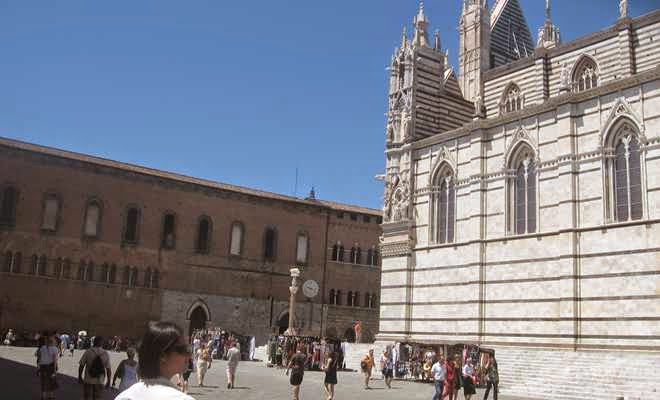The Cathedral in Siena
creeps up on you. This should happen with all good cathedrals. Cathedrals were
meant to be seen as they were in medieval times - from a maze of shadowy
streets. Your first glimpse should be as you emerge from narrow alleyways so you
get the full effect of the facade. Time travel is possible just for a second.
Siena is full of little gems like this. I recommend it for a daytrip from Florence or Pisa. The train service from either town is good which costs about 14 Euros return. It is very important to change trains at Empoli. When you disembark you must take the subway to platform 3 and there a train is waiting to take you south. All trains on ‘The Chianti Line’ are timed to coincide with arrivals. It’s another forty minutes south and the journey is very beautiful. When I was there in June I got to see the famous Tuscan wildflowers cover the fields.
The Stazione in Siena is at the bottom of a steep hill. To catch a bus up to the centre you must pass through a shopping mall to the underground bus station. Then take any bus to Piazza Gramsci where the buses congregate in the old city. You can walk up but it is a thirty minute walk up a steep incline with speeding traffic .
There are plenty of cheap places to eat in Siena and in the evenings the whole town congregates in the restaurants of the Piazza Il Campo. Il Campo also houses the magnificent Palazzo Publico whose tower dominates the piazza. Inside is the ‘Musei Civico’ and this is recommended. This is where the Council of Nine governed the city. The architecture and treasures inside are absolutely superb. There is a beautiful gilded chapel but best of all is a frescoe by Lorenzetti of Allegory of Good and Bad Government. It showed bad government represented by a black horned devil and its effect of devastation across the countryside. Very impressive.
Siena is full of little gems like this. I recommend it for a daytrip from Florence or Pisa. The train service from either town is good which costs about 14 Euros return. It is very important to change trains at Empoli. When you disembark you must take the subway to platform 3 and there a train is waiting to take you south. All trains on ‘The Chianti Line’ are timed to coincide with arrivals. It’s another forty minutes south and the journey is very beautiful. When I was there in June I got to see the famous Tuscan wildflowers cover the fields.
The Stazione in Siena is at the bottom of a steep hill. To catch a bus up to the centre you must pass through a shopping mall to the underground bus station. Then take any bus to Piazza Gramsci where the buses congregate in the old city. You can walk up but it is a thirty minute walk up a steep incline with speeding traffic .
There are plenty of cheap places to eat in Siena and in the evenings the whole town congregates in the restaurants of the Piazza Il Campo. Il Campo also houses the magnificent Palazzo Publico whose tower dominates the piazza. Inside is the ‘Musei Civico’ and this is recommended. This is where the Council of Nine governed the city. The architecture and treasures inside are absolutely superb. There is a beautiful gilded chapel but best of all is a frescoe by Lorenzetti of Allegory of Good and Bad Government. It showed bad government represented by a black horned devil and its effect of devastation across the countryside. Very impressive.
The Duomo is at the top of the hill reached by Via dei Citta. The huge white bulk can be seen through the alleyways glowing in the sun. The sun itself was overhead casting the alleyways into shadow. To get the best view of the Duomo you must see its front facade – the white marble glistens and is carved into a myriad of swirls and statues. Fairytale towers overlook a stain glass window and the piazza below resonates with the hum of hundreds of tourists.
Inside does not disappoint. The nave was massive and held up by striped pillars of green and white. They reminded me of mint humbugs. There were medieval frescoes on the floor of the nave laid out in gold and side altars glittered with gilt. The apse had a beautifully carved wooden choirstall backed by a stain glass window. A side door led to the Libreria Piccomilini. The books have gone but the decoration is stunning. The scenes painted around the room were in such bright colours of scenes of medieval life. The room was interspersed by statues of marble nudes.
Afterwards I rested on a pew in the nave while the tour groups moved around me. I can go at my own pace, when I am tired I sit down – when I am hungry I can eat. But the tour groups had no such luxury. Culture fatigue must set in eventually.
But then I’ve got a long trek back to Pisa and have to wait for two trains. Who is laughing now Steve?

















































